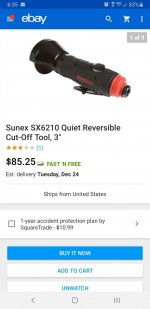If I only have to put some holes in an enclosure for cord grips, it's easy enough to use a step drill. I'd like a better solution for more complicated door panels. For example, the most recent door was 10x12 and has 8 round holes ranging from 7mm to 31mm and a 45x92mm rectangular hole for a 1/2 DIN panel meter.
At a previous job we would take large, complicated doors off the cabinet and have them waterjet, but that's not really an option here.
What I ended up doing was locking the door shut and clamping it to the mill. I drilled the holes with a step drill on the mill, so I could use the DRO. I then milled the rectangle with a 1/2" cutter (5-flute from Helical). This left a lot of cleanup to do with a saw to get the corners sharper and get rid of the burrs from the step drill. The step drills also don't break a chip well, so the swarf scratched up the paint.
I would like a way to mill this complete, but the door is relatively flimsy and vibrates, so when I tried using a smaller cutter, it quickly snapped. Even using stout 1/2" drill bits and cutters, Things weren't very precise. The 1/2 DIN cutout came out undersize.
Any suggestions? I can't dismount the doors on the smaller cabinets, but on a larger cabinet I could.
At a previous job we would take large, complicated doors off the cabinet and have them waterjet, but that's not really an option here.
What I ended up doing was locking the door shut and clamping it to the mill. I drilled the holes with a step drill on the mill, so I could use the DRO. I then milled the rectangle with a 1/2" cutter (5-flute from Helical). This left a lot of cleanup to do with a saw to get the corners sharper and get rid of the burrs from the step drill. The step drills also don't break a chip well, so the swarf scratched up the paint.
I would like a way to mill this complete, but the door is relatively flimsy and vibrates, so when I tried using a smaller cutter, it quickly snapped. Even using stout 1/2" drill bits and cutters, Things weren't very precise. The 1/2 DIN cutout came out undersize.
Any suggestions? I can't dismount the doors on the smaller cabinets, but on a larger cabinet I could.




